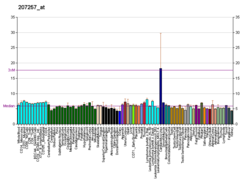| EPO |
|---|
|
| Cấu trúc được biết đến |
|---|
| PDB |
Tìm trên Human UniProt: PDBe RCSB
|
|
|
| Mã định danh |
|---|
| Danh pháp |
EPO, EP, MVCD2, erythropoietin, Erythropoietin, ECYT5, DBAL |
| ID ngoài |
OMIM: 133170 HomoloGene: 624 GeneCards: EPO |
|
|
| Bản thể gen |
|---|
| Chức năng phân tử |
• hormone activity
• protein kinase activator activity
• GO:0001948, GO:0016582 protein binding
• erythropoietin receptor binding
• cytokine activity
|
| Thành phần tế bào |
• extracellular region
• cell surface
• cell body
• extracellular space
|
| Quá trình sinh học |
• erythrocyte maturation
• negative regulation of cation channel activity
• response to interleukin-1
• response to hypoxia
• negative regulation of intrinsic apoptotic signaling pathway in response to osmotic stress
• response to nutrient
• response to salt stress
• negative regulation of erythrocyte apoptotic process
• response to testosterone
• GO:0044324, GO:0003256, GO:1901213, GO:0046019, GO:0046020, GO:1900094, GO:0061216, GO:0060994, GO:1902064, GO:0003258, GO:0072212 regulation of transcription by RNA polymerase II
• response to hyperoxia
• positive regulation of Ras protein signal transduction
• GO:0010260 Lão hóa
• negative regulation of apoptotic process
• GO:1901227 negative regulation of transcription by RNA polymerase II
• response to electrical stimulus
• blood circulation
• response to estrogen
• cellular hyperosmotic response
• GO:0060469, GO:0009371 positive regulation of transcription, DNA-templated
• response to vitamin A
• response to lipopolysaccharide
• acute-phase response
• GO:0035404 peptidyl-serine phosphorylation
• response to axon injury
• hemoglobin biosynthetic process
• positive regulation of neuron differentiation
• positive regulation of cell population proliferation
• regulation of transcription from RNA polymerase II promoter in response to hypoxia
• positive regulation of ERK1 and ERK2 cascade
• positive regulation of neuron projection development
• negative regulation of calcium ion transport into cytosol
• negative regulation of myeloid cell apoptotic process
• activation of protein kinase activity
• embryo implantation
• GO:0072468 signal transduction
• positive regulation of activated T cell proliferation
• positive regulation of protein kinase activity
• negative regulation of neuron death
• GO:0097285 Chết rụng tế bào
• response to dexamethasone
• cell population proliferation
• erythrocyte differentiation
• erythropoietin-mediated signaling pathway
• positive regulation of tyrosine phosphorylation of STAT protein
• regulation of signaling receptor activity
• positive regulation of phosphatidylinositol 3-kinase signaling
|
| Nguồn: Amigo / QuickGO
|
|
| Gen cùng nguồn |
|---|
| Loài |
Người |
Chuột |
| Entrez |
|
|
| Ensembl |
|
|
| UniProt |
|
|
| RefSeq (mRNA) |
|
|
| RefSeq (protein) |
|
|
| Vị trí gen (UCSC) |
Chr 7: 100.72 – 100.72 Mb |
n/a |
| PubMed |
|
n/a |
| Wikidata |
|
Erythropoietin (
;EPO), còn được gọi là hematopoietin hoặc hemopoietin, là một cytokine glycoprotein được tiết ra bởi thận để đáp ứng với tình trạng thiếu oxy tế bào; hormone này sẽ kích thích sản xuất hồng cầu (erythropoiesis) trong tủy xương. Mức EPO thấp (khoảng 10 mU/mL) liên tục được tiết ra đủ để giúp giữ ổn định mức hồng cầu bình thường. Nguyên nhân phổ biến của thiếu oxy tế bào dẫn đến nồng độ EPO cao (lên đến 10 000 mU / mL) có thể là thiếu máu, và thiếu oxy trong máu do bệnh phổi mãn tính.
Erythropoietin được sản xuất bởi các nguyên bào sợi kẽ trong thận kết hợp chặt chẽ với mao mạch peritubular cùng với ống lượn gần. Nó cũng được sản xuất trong các tế bào perisinusoidal trong gan. Sản xuất ở gan chiếm ưu thế trong giai đoạn thai nhi và mới sinh vài tuần; sản xuất thận lại chiếm ưu thế ở tuổi trưởng thành.
Erythropoietin ngoại sinh, erythropoietin của người tái tổ hợp (rhEPO) được sản xuất bằng công nghệ DNA tái tổ hợp trong nuôi cấy tế bào và được gọi chung là tác nhân kích thích hồng cầu (ESA): hai ví dụ là epoetin alpha và epoetin beta. ESA được sử dụng trong điều trị thiếu máu do bệnh thận mãn tính, thiếu máu trong hội chứng rối loạn sinh tủy, và bị thiếu máu từ hóa trị ung thư. Rủi ro điều trị bao gồm tử vong, nhồi máu cơ tim, đột quỵ, huyết khối tĩnh mạch và tái phát khối u. Nguy cơ gia tăng khi điều trị EPO làm tăng nồng độ hemoglobin trên 11 g/dL đến 12 g/dL: tuy nhiên, điều này là tránh được.
rhEPO đã được sử dụng trái phép như một loại thuốc tăng cường hiệu suất. Nó thường có thể được phát hiện trong máu, do sự khác biệt nhỏ so với protein nội sinh; ví dụ, nhờ các đặc điểm sửa đổi sau dịch mã.




